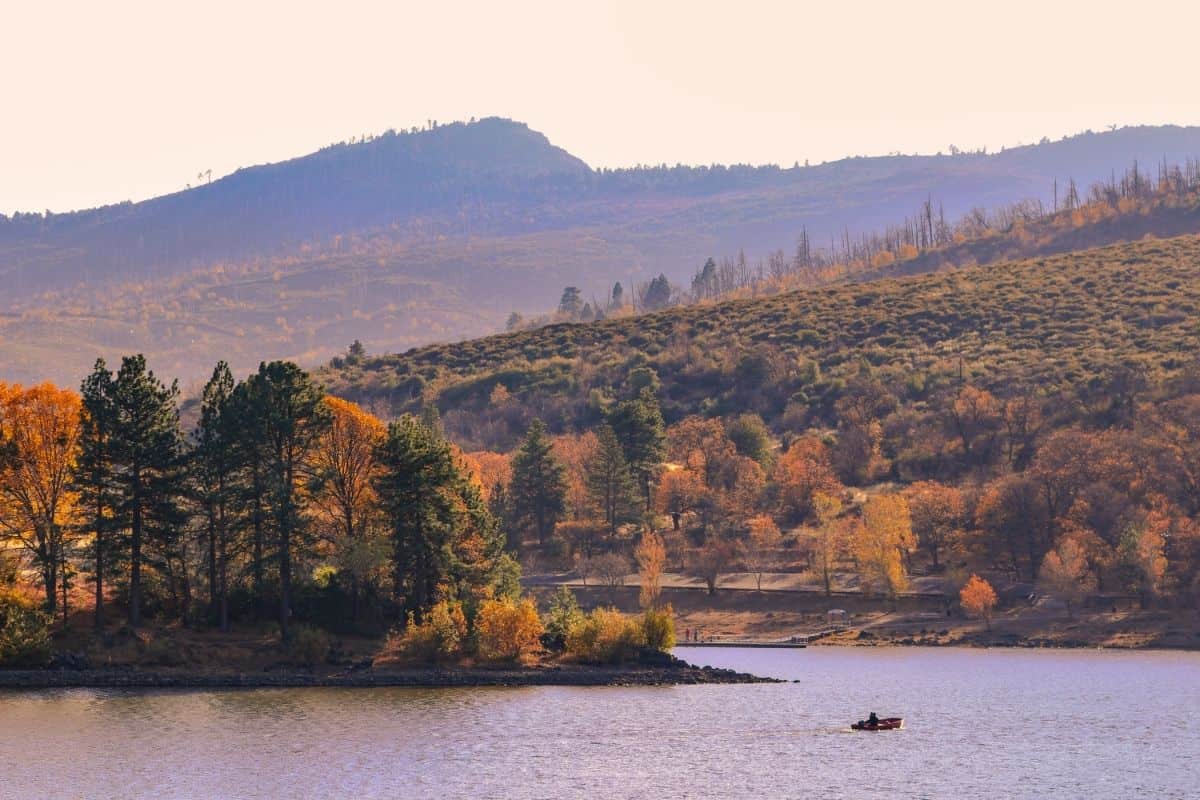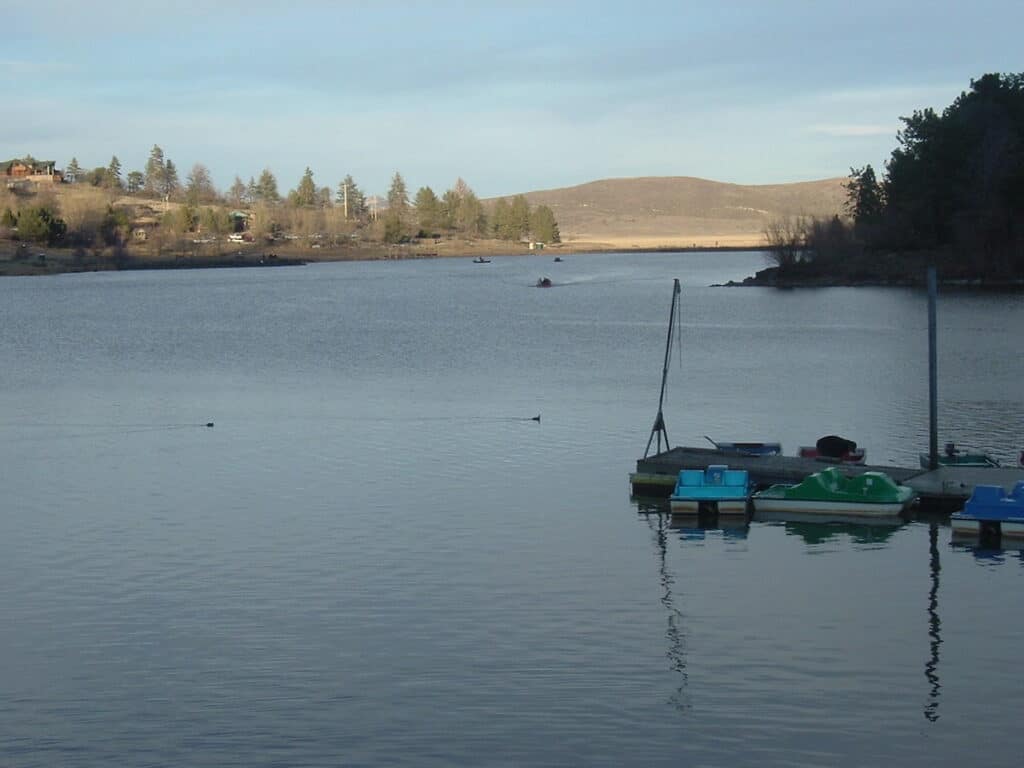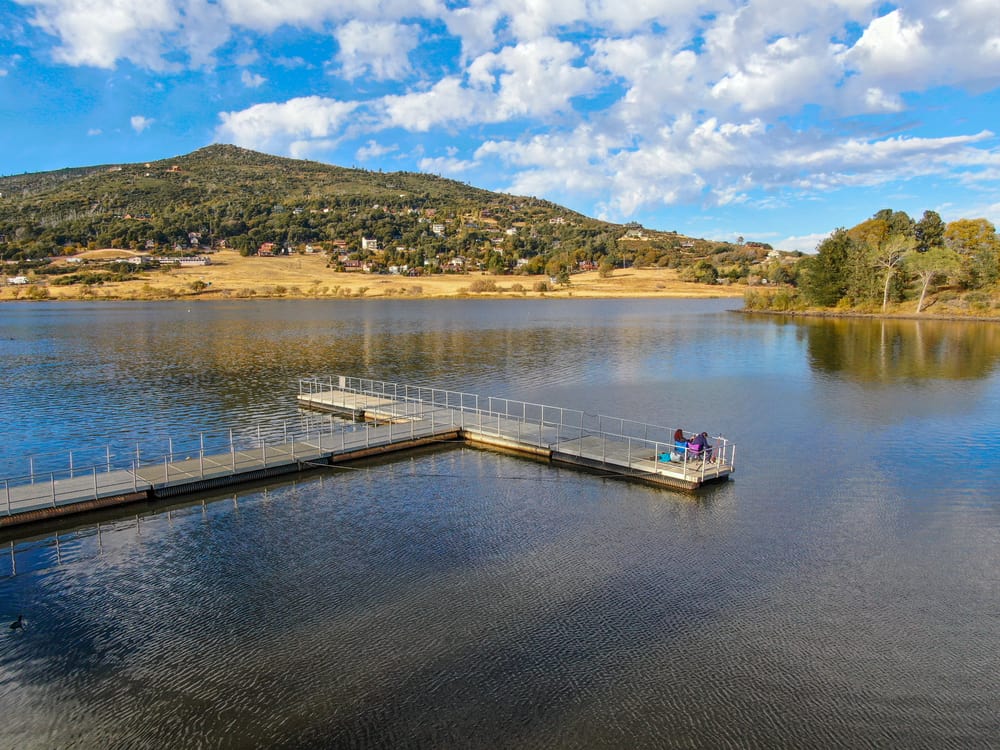Lake Cuyamaca is about an hour east of downtown San Diego, but at 4,620 feet above sea level in the Cuyamaca Mountains, it might as well be a world away.
For starters, thanks to that high elevation, the water temperature stays far cooler in the summertime than nearby fishing lakes, allowing trout to be caught year-round in a mountain setting.
Stocked trout are only one of many species present in the lake. This 110-acre lake is a sometimes underrated bass fishery, and many anglers target channel catfish, crappie and bluegill.
Even the occasional sturgeon is caught, usually by taking a surprised trout angler’s baited hook.
The lake offers day-use and camping opportunities through the Lake Cuyamaca Recreation and Park District.
Lake Cuyamaca Bass Fishing
Largemouth bass, including Florida-strain bass, are the most abundant and largest species of bass in the lake, but this also is likely the only lake in San Diego County where you have a shot at hooking smallmouth bass.
Many anglers who fish Lake Cuyamaca consider it underrated, largely because you have a legitimate shot at catching good numbers of big bass, including some into the 10- or 11-pound range.
The lake record largemouth is a bit over 14 pounds and has stood for a quarter century, so history plus the shorter growing season in cool water makes it less likely you’ll see one of those Florida bass hit the 20-pound mark.
While the lake doesn’t boast the absolute giant size bass we’ve come to expect from some of California’s top trophy bass lakes, there is very good bass fishing here.
For one, there are good numbers of fish. Also, these bass see less fishing pressure and can be easier to catch than bass that constantly have lures passing their noses.
We’ve placed Lake Cuyamaca on our rundown of the best largemouth bass fishing lakes in Southern California.
Catching bass in this reservoir is going to be similar to catching bass elsewhere. Just keep in mind when picking your lures and techniques, Cuyamaca is considered a shallow lake.
Finding structure in the water will be your best option, whether that is a dock, aquatic plants or rocks.
Your lure selection will vary depending on the time of year and the type of structure you are fishing, but most bass lures either mimic prey species such as smaller fish or crayfish, or they provoke an attack response from these aggressive and often territorial fish.
As mentioned, Lake Cuyamaca also has a small population of smallmouth bass, which were stocked many years ago.
While it’s not one of the best smallmouth bass fishing spots in California (most of those are farther north, except for a good fishery at Lake Havasu), if you are in the San Diego area and want to catch one within an hour or two, this is the place.
Smallmouths are notoriously hard-fighting fish for their size, so they are very fun to catch, whether you’re targeting them specifically or catch one incidentally while fishing for largemouth bass or other game fish.
If specifically looking for smallmouths, try slightly smaller lures than for the largemouths and work rocky structures.
Note that smallmouth bass must be released unharmed, while you can keep a limit of largemouths within the guidelines.
Catch more bass
Bass Fishing: Simple How-To Techniques and Tips.
Lake Cuyamaca Trout Fishing
The reason many anglers visit Lake Cuyamaca is for its rainbow trout fishing.
Around 45,000 pounds of rainbow trout are stocked each year by the park district, and the California Department of Fish and Wildlife also has stocked the lake as well.
While some trout are stocked large, others survive long enough to put on some serious pounds. The lake record trout at last check was 17.5 pounds.
There are numerous ways to catch trout in the lake. Fly fishing and using dough baits such as PowerBait are two of the most popular ways to catch trout.
Inline spinners or small spoons such as a Super Duper work well when the bite is tough.
The best lure and color choices will vary by season, time of day and just the fickle nature of fish. Bring a selection and try them out until you hit on the right formula that day.
Don’t be afraid to politely ask other anglers how they are doing and what they are fishing with, or take note when other people are reeling them in when you can’t buy a bite.
While you will run into people who don’t share their “secrets,” many trout anglers are happy to help out.
If that fails, go to the bait and tackle shop. They should be happy to point you in the right direction!
Depending on the season, trout can feed near the shoreline or in shallow water, or retreat to the depths to escape the heat (usually in summer).
One of the first orders of business in catching trout is simply to find them, but once you do your odds of catching more will go up significantly.
Try out different depths and techniques and watch what successful anglers around you are doing.
More information: Best Rainbow Trout Fishing Lakes in California and Trout Fishing: How-To Techniques and Tips.
Catfish Fishing
While bass and trout attract much of the attention, a fair number of anglers who visit Lake Cuyamaca come to fish for channel catfish.
This species is especially popular among anglers who want to bring home a meal, because channel catfish are tasty, good-sized, and often available in abundance.
The lake record channel cat is over 28 pounds, but you’re more likely to catch catfish ranging from 3 to 8 pounds, which are the perfect eating size.
In fact, we like your odds of catching cats here so much that we’ve included Lake Cuyamaca on our listing of the best catfish lakes and rivers in California.
Channel catfish get their name from often living in rivers and creeks in their native range, which includes the Mississippi River system.
In reservoirs, you’ll still often find them hanging out in old creek channels, although they will move around a fair bit when they are feeding most actively, especially in low-light conditions.
Perhaps the best bait to use for catfish is cut bait, if using pieces of fish is allowed on the lake. The next best options include chicken livers or prepared stink baits.
Catfish are opportunistic feeders, meaning they are not picky when it comes to food. They will eat most things but like other fish, they prefer what is most commonly abundant in their waterway.
Matching your bait to the most abundant food source in the lake will likely yield the best results, so fishing with pieces of crappie or trout left after cleaning those fish is often a good way to go.
Want more? We offer up some of the simplest fishing techniques, quick tips, and best baits to put catfish on your stringer.
Crappie Fishing
Lake Cuyamaca’s crappie fishing can be action-packed on the right day.
As with catfish, they are a preferred fish to eat by many freshwater anglers. The only problem with crappie is they are on average smaller than other fish in the lake, so you likely will need to catch several to make a meal out of them.
Most crappie that are caught under a pound (and sometimes far under), although the lake record is 2.5 pounds.
It is best to use light gear and small lures when crappie fishing. Jigs with a slip bobber or other lures are the most productive way to catch them. Check regulations before using live baits.
Crappie are most often caught around boat docks and brush piles, typically in the deeper holes of the lake for much of the year.
That doesn’t mean you can’t catch them shallow at times, especially during the spring spawn.
Lake Cuyamaca is on our list of best crappie fishing lakes in California.
Other Fish You Might Catch
Bluegill
If you went fishing as a kid more than likely you caught a bluegill.
We haven’t met a kid or an adult who likes to fish and doesn’t love catching these feisty little fish from time to time.
Bluegill are more often than not quite easy to catch, they put up a great fight for their size, and they are tasty if you catch them big enough to bother cleaning.
They also make great catfish bait, though pay attention to the regulations before using fish for bait.
Catching bluegill usually involves a piece of nightcrawler or a smaller worm or mealworm, a smallish hook and a bobber.
Fish the shallow areas that have structures, including weed beds, or fish under a shady dock. Bluegill are almost certain to be there.
Sturgeon
White sturgeon were stocked in Lake Cuyamaca for a short period, but these long-lived fish are still caught in the lake … often getting hooked accidentally by trout or catfish anglers dunking some fresh bait.
White sturgeon can grow to good sizes, especially in the big rivers systems farther north.
But even landlocked in a Southern California lake can get some heft to them. The Lake Cuyamaca record fish maxed out the scales at over 50 pounds and measured 62 inches long.
Few anglers target sturgeon because there are relatively few of them in the lake, but if you set out to catch one, use heavy gear, a large hook and fresh fish or nightcrawlers for bait.
Just know that you’ll probably still catch more catfish and you’ll need a little luck on your side to tangle with a sturgeon here.
Planning Your Trip
Lake Cuyamaca (a.k.a. Cuyamaca Lake) is only about an hour northeast of San Diego, so it’s not far for a day trip or an overnight excursion.
The Lake Cuyamaca fishing derby in late September is a great time to take a kid or two trout fishing.
Bank and Boat Access
Lake Cuyamaca fishing spots are easy to find.
It has a public boat ramp, a handicapped fishing dock, and multiple areas to fish from the bank and fishing docks.
Along the edge, the lake has hiking trails on gentle slopes, so you are sure to find a fishing spot that fits your needs.
Additionally, Highway 79 runs along about two-thirds of the lake with multiple areas to pull over and enjoy the beauty of this California lake, perhaps while casting a line.
If you want to get out on the water, bring your own boat or take advantage of boat rentals at Chamber’s Park.
Private boats must be inspected for quagga mussels and other aquatic invasive species.
You can use float tubes near the shore, but you must wear waders and follow other guidelines.
See the Lake Cuyamaca Park District website for more information, including various rules for the lake.
Camping and Supplies
Chamber’s Park on the north shoreline offers a modest number of campsites and a few cabins as well.
Cuyamaca Rancho State Park is on the southern side of the reservoir and offers several campgrounds in the surrounding pine forest, including family camping at Paso Picacho Campground about two miles from the lake.
Lake Cuyamaca Restaurant & Store offers eats for both you and the fish (bait and tackle).



